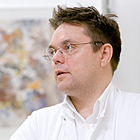

|
|||||
| ALCL | RESEARCH GROUPS | FEATURED PUBLICATIONS | TOOLS | ||
Leukemogenesis lAb

Group Leader:
Prof. Justus Duyster
Contact:
Universitätsklinikum Freiburg, Klinik für Innere Medizin I
Schwerpunkt Hämatologie, Onkologie und Stammzelltransplantation
Hugstetter Str. 55
D 79106 Freiburg
Telefon +49 761 270 34 06 0
Telefax +49 761 270 32 06 0
Funding:
DFG
BMBF
Dt. Krebshilfe
Sander Stiftung
DJ Carreras Stiftung
Description: ALCL is a subgroup of Non-Hodgkin-Lymphomas characterized by CD30+ cells of T- or Null-Cell-origin. In over 50% of ALCL, a t(2;5) translocation leads to a fusiongene NPM-ALK, which encodes an oncogenic tyrosine kinase. The spatio-temporal expression of NPM-ALK seems to be important for the phenotype and we aim to investigate this by lineage- and differential-specific expression of NPM-ALK. The aim is to establish a mouse model similar to human ALCL, which can be used for disease characterization and drug testing.
We have previously established a murine bone marrow transplantation model and showed that retroviral NPM-ALK transduction into murine bone marrow (BM) leads to a histocytic or plasmocytic disease depending on viral titre. So far there is no optimal mouse model mimicing closely human ALCL. To induce a T-lymhoid ALCL in mice, we currently expressed NPM-ALK in a spatio-temporal manner. We have inserted a floxed ‘stop cassette’ between the retroviral promoter and NPM-ALK. This construct guaranties the specific expression of NPM-ALK, when BM from mice is used, where the enzyme Cre-recombinase is driven by a specific promoter. Cre recognizes the loxP-sites, so the stop-cassette is released and NPM-ALK can be expressed spatio-temporally depending on the promoter being used. In our study we used BM from CD4-Cre mice. CD4 promoter is active in dopple-positive T-cells. We also used Lck-Cre mice, where Cre gets activated in earlier dopple-negative T-cells. We could show that the expression of NPM-ALK in CD4-Cre BM leads to a histocytic phenotype with a disease latency of 3 months. On the other hand, NPM-ALK in Lck-Cre mouse BM induced a CD4+CD8+ T-cell phenotype with a latency of 5 months. These tumours also showed CD30 expression, which is an important feature of human ALCL. We are further developing this murine ALCL model, to test ALK inhibitors in a preclinical setting and to investigate the molecular pathophysiology of ALK positive lymphomas.
Another focus of our group is the signalling of CD30 in ALCL. Here we are particularily interested in the regulation of NF?B in ALCL by NPM-ALK and CD30 signalling.
Collaborators: Mathas (Berlin)
Publications:
1- Bassermann F, von Klitzing C, Illert AL, Münch S, Morris SW, Pagano M, Peschel C and Duyster J (2007). Multisite phosphorylation of NIPA at G2/M involves cyclin B1/CDK1.
J Biol Chem. 2007 Mar 27
2- Miething C, Peschel C, Duyster J. (2006). Targeting the oncogenic tyrosine kinase NPM-ALK in lymphoma: the role of murine models in defining pathogenesis and treatment options.
Curr Drug Targets. 2006 Oct;7(10):1329-34.
3- Bassermann, F., C. von Klitzing, S. Munch, R.Y. Bai, H. Kawaguchi, S.W. Morris, C. Peschel, and J. Duyster. 2005. NIPA defines an SCF-type mammalian E3 ligase that regulates mitotic entry.
Cell 122:45-57.
4- Ouyang, T., R.Y. Bai, F. Bassermann, C. von Klitzing, S. Klumpen, C. Miething, S.W. Morris, C. Peschel, and J. Duyster. 2003. Identification and characterization of a nuclear interacting partner of anaplastic lymphoma kinase (NIPA).
J Biol Chem 278:30028-30036.
5- Miething, C., R. Grundler, F. Fend, J. Hoepfl, C. Mugler, C. von Schilling, S.W. Morris, C. Peschel, and J. Duyster. 2003. The oncogenic fusion protein nucleophosmin-anaplastic lymphoma kinase (NPM-ALK) induces two distinct malignant phenotypes in a murine retroviral transplantation model.
Oncogene 22:4642-4647.
Weblinks:
http://www.med3.med.tu-muenchen.de/team/Duyster.html
Tools:
Conditional NPM-ALK retroviral vectors ALCL cell lines (Sudhl1, JB6, Karpas 299)
Techniques:
Virus production
BM-infection and -transplantation
Establishing syngenic or Xenograft mouse models